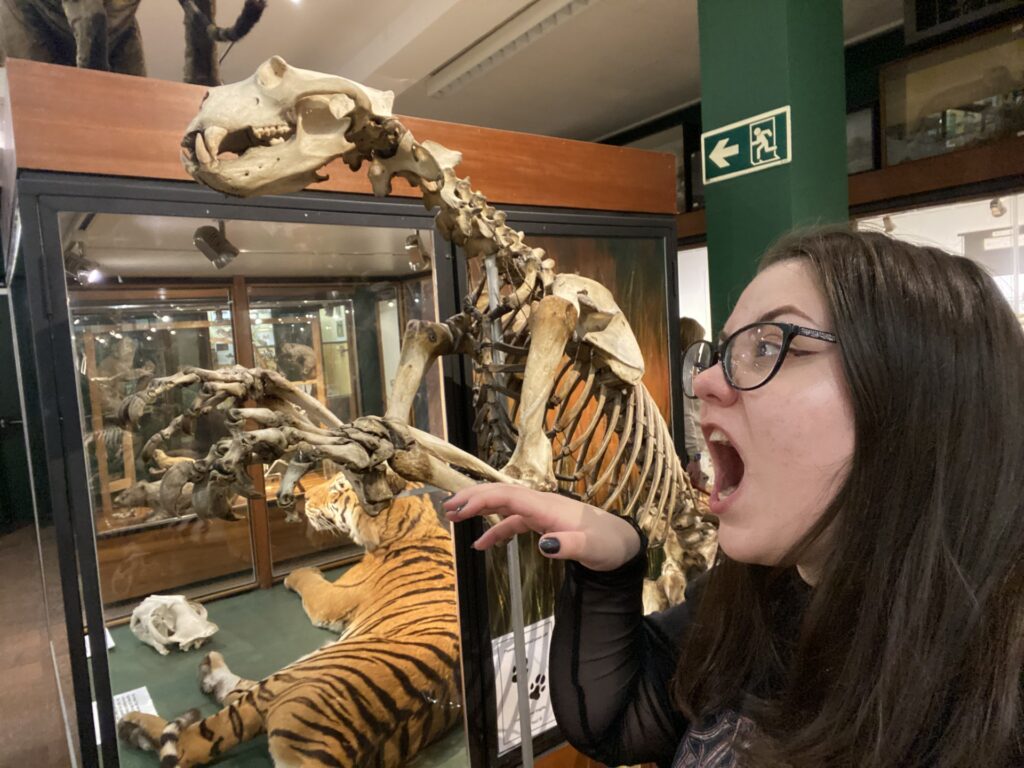
| Academic Year | 2024-2025 |
| r03cb24@abdn.ac.uk | |
| Institution | University of Aberdeen |
Biography
School: School of Geosciences
Pronouns: she/her
Project: Reconstructing the spatial ecology of cave bears: integrating geochemical, biomolecular and microwear analysis to explore the relationship between range size, sex and dietary ecology in extinct and ancestral European Late Pleistocene Ursidae
Supervisors: Prof Kate Britton, Dr Maarten Blaauw & Dr Edouard Masson-MacLean
Undergraduate Education: BA Natural Sciences, University of Cambridge
Postgraduate Education: MSc Natural Sciences, University of Cambridge
Research: The current dominant Ursid in Europe is the Brown Bear, Ursus arctos. However, this was not always the case. Pleistocene brown bears had to coexist with diverse megafauna such as the Cave Bears, Ursus spelaeus. Unlike brown bears, these bears are thought to have had a predominantly plant-based diet (Bocherens et al 1990, Naito et al 2020) despite being larger than any extant bear species. This project concerns itself with how these different bears bears lived; what they ate, where they drank, where they foraged and if any of these factors depended on climate, geographical location, biological sex or changed over short time scales (seasonally) or longer time scales (thousands of years). We aim to determine to what extent each of these factors left the cave bear vulnerable to extinction but allowed the survival of brown bears.
There are many archaeological sites in Eastern Europe which have not been examined in detail and we hope to rectify this, adding to global knowledge on past bear behaviours. The extent of bear habitats in Europe used to cover Britain, but it is currently not known exactly which species populated the British Isles when and how many episodes of habitation there were. It has also come to our attention that the exact timing of the extinction of native bears in Britain has not been constrained due to overlap with imported bears for entertainment (Yalden 1999).
I will employ the power of isotope systems to reveal the bear’s nature. δ13C can inform us about their long-term diet; coupled with microwear which can tell us about their last meal before death. There may be biases associated with specimens that died during hibernation. This has often been combined with δ15N which reveals trophic level (Krajcars et al 2016). The results largely agree on a plant-based diet with a few anomalous sites in Romania noted study after study (Richards et al 2008). δ18O will inform us of the climate so we can investigate if climatic perturbations or simple seasonality are correlated with changes in diet (as Fernandez-Garcia et al 2024 has done with ungulates). Finally, Strontium isotopes have never been applied to bear species. It is extremely pertinent we understand where these animals were sourcing their nutrition and if the age or sex of the individuals affected their territorial boundaries. It is also important to reconstruct ursid movements unimpeded by human structures as they are today. All of this in combination has the potential to reconstruct animal behaviour in such detail, their movements can be imagined as a documentary.
Background
As a palaeontologist, I have worked on a wide range of taxa from time periods much older than the Pleistocene. However, the behaviour of hominins of the time influencing the survivability of my study species has never been such an important factor in my previous work. During this project, I have the opportunity to become familiar with the discipline of Archaeology.
My project is not just rooted in the past. As a proud Romanian, bears hold a special place in my heart. Romania has a rich record of Ursid fauna, past and present. Romanian bears are currently in an ecological trap, caught between ever decreasing natural resources from deforestation and the danger of being shot given the recent increase in bear and human contact and new legislation (see article below). It is possible the features that made brown bears resourceful and hardy in the past has brought them into direct contact with us and if we do not preserve their habitats, we may see their territories fragments even more across Europe. As large animals with complex needs, this could put them at risk of extinction as their earlier cousin were also subjected to.
https://www.romania-insider.com/romania-increases-bear-hunting-quota-july-2024
Christine also featured in the Pebbles, Plates & Planet Podcast, episode 1. Listen here!
References:
Bocherens H, Fizet M, Mariotti A, 1990. [Evidence for vegetarian diet of cave bear (Ursus spelaeus) from isotopic biogeochemistry (13C, 15N) of fossil vertebrate collagen]. C R Acad Sci, Série II, Paris 311:1279–1284. French.
Fernández-García, M., Pederzani, S., Britton, K., Agudo-Pérez, L., Cicero, A., Geiling, J. M., Daura, J., Sanz, M., and Marín-Arroyo, A. B.: Palaeoecology of ungulates in northern Iberia during the Late Pleistocene through isotopic analysis of teeth, Biogeosciences, 21, 4413–4437, https://doi.org/10.5194/bg-21-4413-2024, 2024.
Magdalena Krajcarz, Martina Pacher, Maciej T. Krajcarz, Lana Laughlan, Gernot Rabeder, Martin Sabol, Piotr Wojtal, Hervé Bocherens, Isotopic variability of cave bears (δ15N, δ13C) across Europe during MIS 3, Quaternary Science Reviews, Volume 131, Part A, 2016, Pages 51-72, ISSN 0277-3791, https://doi.org/10.1016/j.quascirev.2015.10.028
(https://www.sciencedirect.com/science/article/pii/S0277379115301499)
Naito, Y.I., Meleg, I.N., Robu, M. et al. Heavy reliance on plants for Romanian cave bears evidenced by amino acid nitrogen isotope analysis. Sci Rep 10, 6612 (2020). https://doi.org/10.1038/s41598-020-62990-0
Richards MP, Pacher M, Stiller M, Quilès J, Hofreiter M, Constantin S, Zilhão J, Trinkaus E. 2008a. Isotopic evidence for omnivory among European cave bears: late Pleistocene Ursus spelaeus from the Pestera cu Oase, Romania. PNAS. 105(open in a new window):600–604.10.1073/pnas.0711063105
Yalden, D. 1999: The History of British Mammals. – Poyser, London





















































